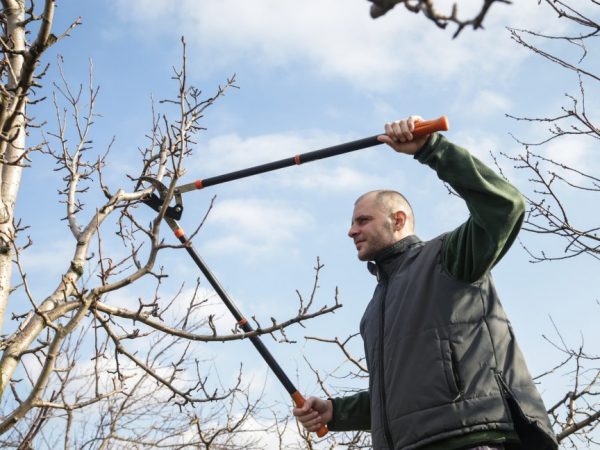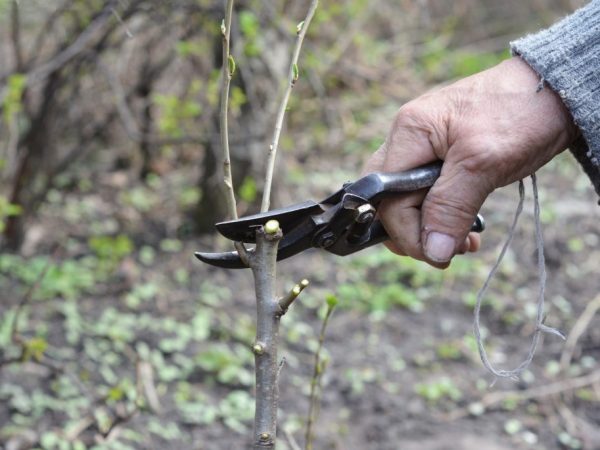Correct pear formation
In order for a planted seedling to give good yields in the future, it must be properly formed. Let's consider how to correctly form a pear. We will also talk about how often you need to prune the branches of the tree so as not to harm the plant.

Correct pear formation
What is pruning for?
Let's make a reservation right away that shaping a pear is nothing more than pruning branches, which must be done in accordance with certain rules. Removing branches is necessary not only in order to increase yields. This procedure helps to rejuvenate plantings and protects trees from diseases and pests.
If you systematically prune, then powerful branches will form that will not break under the weight of the fruit, even in the most fruitful year. In addition, trees that are properly formed bear fruit much longer than those that are not being formed.
Formation methods
There are two ways to form a pear crown:
- The first method involves deleting some entire branches. They are clipped right at the base. It is conventionally called thinning.
- The second method involves deleting only a certain part of the branch. The rest of it becomes thicker. This method is suitable for those gardeners who want to form a small, compact tree. Gardeners call this method of formation by shortening.
The formation of the crown of a pear should be done throughout the entire time of growing the tree. In each specific period, a certain type of branch removal is performed. There are 3 of them:
- formative;
- supportive;
- anti-aging.
Each type of pruning is equally important for the normal development of the plant. From the names it is easy to guess that the first type of pruning involves directly removing all unnecessary branches. Supportive pruning is done to keep the crown from losing its shape. And anti-aging involves the removal of old branches that practically do not bear fruit. During rejuvenating pruning, sometimes only part of the branch is removed.
Crown formation scheme
The crown of a pear is formed in 4 years.
Formation in the 1st year
The formation of the crown of a young pear begins immediately after planting the seedling. In the first year, the lower tier of the tree is laid. Cut the plant at a height of 0.8-0.85 m from the ground. At a height of 50 cm from the ground, remove all the buds that have appeared. This is the so-called standard area. The remaining buds will give shoots, which will subsequently form the lower tier of the tree. This completes the work on the formation and pruning of the pear in the first year.
Formation in the 2nd year

The formation procedure is carried out in the spring
The formation of the crown of a pear in the second year involves the determination of skeletal branches. The skeleton is the basis of the future tree. Therefore, we choose the 3 most powerful shoots, which are not very close to each other, and from different sides of the trunk. You can leave 4 shoots, but no more.We shorten the branches that form the skeleton, delete the rest. We form a ring from the shoots remaining on the trunk of a young tree. Several shoots should have formed on each branch by this time. We leave one of them intact, shorten the rest. We perform this procedure in the spring.
We remove branches with a sharp garden tool, which should be disinfected before use.
Formation in the 3rd year
Pruning and shaping the crown of a pear at this stage involves laying the upper tier of the crown and is done in the spring. The lower branch of the upper tier should be located 60 cm from the upper branch of the lower tier. An error of 7-10 cm is allowed. This year we leave 2 shoots on the trunk of a young tree, located on different sides of it. Remove the rest of the shoots. To make the shoots remaining on the tree powerful, we shorten them slightly. In parallel, in the third year, we slightly shorten all the branches of the lower tier. Each branch of the lower tier should have no more than 4 shoots. We remove the rest of the processes.
Formation in the 4th year
This is the last stage in which you need to form the last branch of the upper tier. We leave the shoot that has the most favorable location in relation to the already formed branches, and delete the rest. We also remove on each branch the shoot that is closest to its edge. This procedure is carried out in the spring.
We have considered the optimal scheme for forming a tree. This is not the only option, but it can increase the yield of any variety. If there is not enough space in the garden, then you can form seedlings with a spindle. This method assumes the presence of several powerful and relatively long branches at the bottom of the tree. Closer to the top, the branches are shortened. In general, the tree in shape ultimately resembles a cone.
After removing the branches, be sure to process the cut sites with garden pitch. This will protect the plant from disease.
Autumn and summer pruning
If in the first 2 years after planting it is necessary to form the crown of a young pear only in the spring, then in all subsequent years it is necessary to deal with the removal of excess branches in summer and autumn.
In the summertime, you can get rid of damaged branches. You can also shorten shoots that are developing too actively. All manipulations should be completed by the end of June. Removing branches and shoots during the period of formation and ripening of fruits can negatively affect productivity.
In autumn we remove branches damaged by pests and diseases. In parallel, you should get rid of the damaged bark. The branches must be removed at least 20 days before the onset of frost. And since there is always the possibility of early frosts, it is advisable to finish all work by the end of September.
Do not delete a large number of branches in one go. If the tree is too overgrown, then first remove those branches that thicken its crown the most. After the cut sites have healed, remove the rest of the shoots.
Conclusion
We looked at how to properly shape the crown of a pear. We did not talk about the winter removal of branches due to the fact that experts strongly discourage making any manipulations with trees after the onset of cold weather. But if you decide to get rid of unnecessary shoots in winter, then you should choose a warm February day. Young plants, while it is better not to touch. For them, this procedure will do more harm than good.


